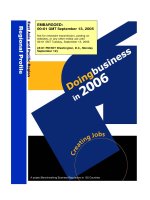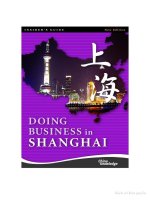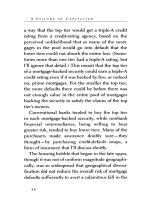Understanding business 10th chapter 3b doing business in global market
Bạn đang xem bản rút gọn của tài liệu. Xem và tải ngay bản đầy đủ của tài liệu tại đây (1.55 MB, 63 trang )
Chapter 03
0
Doing Business
in
Global Markets
McGraw-Hill/Irwin
Copyright © 2013 by The McGraw-Hill Companies, Inc. All rights reserved.
3-2
Why Trade With Other Nations?
•
Global trade allows countries to produce what they
make best and buy what they need from others.
not used
3-3
3-4
TRADING with OTHER NATIONS
•
Countries with abundant natural resources (like Venezuela or Russia) need
technological resources from other countries (like Japan).
3-5
HOW FREE TRADE
BENEFITS the WORLD
Global trade has led the world in a new direction:
•
Literacy rates worldwide have increased from 56% in 1950 to 99% in 2012.
•
Life expectancy in less developed areas rose from 40.9 years in 1950 to 70.5 years
in 2012.
Source: The World Bank, June 2014
3-6
Company % of
Earnings From Outside U.S.
Company
Total Assets Reinvested Overseas in 2011
Total Assets Reinvested Overseas in 2012
Total Added in 2012
GENERAL ELECTRIC CO
$102,000
$108,000
$6,000
PFIZER INC
$63,000
$73,000
$10,000
MICROSOFT CORP
$44,800
$60,800
$16,000
MEREC CO
$44,300
$53,400
$9,100
JOHNSON & JOHNSON
$41,600
$49,000
$7,400
INTL BUSINESS
$37,900
$44,400
$6,500
EXXON MOBIL CORP
$47,000
$43,000
-$4,000
CITIGROUP INC
$35,900
$42,600
$6,700
CISCO SYSTEMS INC
$36,700
$41,300
$4,600
APPLE INC
$23,400
$40,400
$17,000
MACHINES CORP
/>
3-7
PLEASURE DOING BUSINESS
Best Countries for Business out of 183 Countries
Economy
Ease of Doing Business Rank Starting a Business Paying Taxes
Trading Across
Borders
Singapore
1
3
5
1
Hong Kong SAR, China
2
5
4
2
New Zealand
3
1
23
21
United States
4
20
64
22
Denmark
5
40
12
8
Malaysia
6
16
36
5
Korea, Rep.
7
34
25
3
Georgia
8
8
29
43
Norway
9
53
17
26
United Kingdom
10
28
14
16
.
© 2013 The World Bank, All Rights Reserved
3-8
3-9
CAN YOU SPARE A DIME?
Rank
Name
Net Worth
Age
Source
Country of Citizenship
1
Carlos Slim Helu & family
$73 B
74
telecom
Mexico
2
Bill Gates
$67 B
58
Microsof
United States
3
Amancio Ortega
$57 B
77
Zara
Spain
4
Warren Buffet
$53.5 B
83
Berkshire Hathaway
United States
5
Larry Ellison
$43 B
69
Oracle
United States
6
Charles Koch
$34 B
78
diversified
United States
6
David Koch
$34 B
73
diversified
United States
8
Li Ka-shing
$31 B
85
diversified
Hong Kong
9
Liliane Betencourt & fami
$30 B
91
L'Oreal
France
64
LVMH
France
ly
10
Bernard Arnault & family
$29 B
3-10
Forbes 2014
Why Trade with
Other Nations?
LG1
TRADING with OTHER NATIONS
•
Countries with abundant natural resources (like Venezuela or
Russia) need technical resources from other countries (like
Japan).
•
Global trade allows countries to produce what they make best
and buy what they need from others.
•
Free Trade – The movement of goods and services among nations
without political or economic barriers.
3-11
TRADING with OTHER NATIONS
Theories of Advantage
Comparative
Absolute
3-12
COMPARATIVE ADVANTAGE
•
Comparative Advantage -- A country should sell the products it
produces most efficiently and buy from other countries the products it
cannot produce as efficiently.
3-13
Theories of Advantage
Comparative
U. S.
China
China
U. S.
Software
3-14
Clothing
ABSOLUTE ADVANTAGE
•
Absolute Advantage -- A country has a monopoly on producing a
specific product or is able to produce it more efficiently than all other
countries.
3-15
Theories of Advantage
Absolute
= Virtual Monopoly
South Africa
The Rest of the
World
Diamond Production
3-16
IMPORTING and EXPORTING
•
Importing -- Buying products from another country.
•
Exporting -- Selling products to another country.
•
The U.S. is the largest importing nation in the
world.
3-17
I
N
G
G
L
O
B
A
L
3-18
U
R
E
•
G
Balance of Trade -- The total value of a nation’s exports compared to its imports
L
measured over time.
O
•
•
Trade
B Surplus -- When the value of a country’s exports is more than that of its imports.
A
Trade Deficit -- When the value of a country’s exports is less than that of its imports.
L
T
R
A
D
3-19
Rising U.S. Trade Deficit
/>
Source: US Dept of Commerce, Bureau of Economic Analysis
3-20
GETTING INVOLVED in
EXPORTING
•
Exporting provides a great boost to the
U.S. economy.
•
It is estimated, every $1 billion in U.S.
dollars exported generates over 7,000
U.S. jobs.
3-21
BALANCE of PAYMENTS
•
Balance of Payments -- The difference between money coming into a country (from
exports) and money leaving the country (from imports) plus other money flows.
•
The goal is to have more money flowing into a country than out – a favorable
balance.
•
An unfavorable balance is when more money flows out of a country.
3-22
UNFAIR TRADE PRACTICES
•
Dumping -- Selling products in a foreign country at lower prices than those charged in
the producing country.
•
Dumping is prohibited in the U.S.
•
China, Brazil and Russia have been penalized for dumping steel in the U.S.
3-23
KEY STRATEGIES for REACHING GLOBAL MARKETS
International joint ventures
Licensing
Least
Contract
Exporting
Franchising
Manufacturing
Amount of commitment, control, risk and profit potential
and strategic alliances
Foreign direct
investment
Most
3-24
E
N
S
•
Licensing
-- When a firm (licensor) provides the right to manufacture its product or use
I
its trademark to a foreign company (licensee) for a fee (royalty).
N
•
G
Licensing can benefit a firm by:
-
Gaining revenues it wouldn’t have otherwise generated.
-
Spending little or no money to produce or market their products.
3-25









